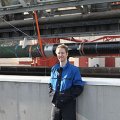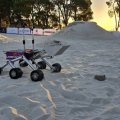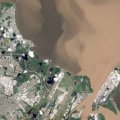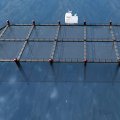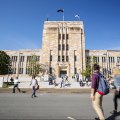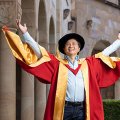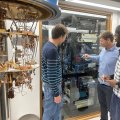Italy, a key nation in aerospace research, has signalled its intention to collaborate more closely on hypersonics research with The University of Queensland (UQ), Australia.
UQ and CIRA (the Italian Aerospace Research Agency) will sign an agreement to facilitate cooperation in hypersonics, at Brisbane, Australia, on Friday, May 29.
Hypersonics is the science and technology of flight at approximately Mach 5 (five times the speed of sound, or 5500 km/h) and above.
Hypersonic flight includes high speed intercontinental transport in Earth’s atmosphere, and is a critical enabling technology for space access, for applications such as communication and navigation satellites, climate monitoring, space science, and planetary exploration.
UQ Acting Deputy Vice-Chancellor (Research) Professor Max Lu welcomed the agreement which he said would benefit researchers in both countries and advance hypersonics technologies.
"The new agreement complements UQ's successful history of hypersonics ground and flight testing, and collaboration with about 20 universities and research organisations, including space agencies NASA in the US and DLR in Germany," Professor Lu said.
Dr Gennaro Russo, who is the Head of Space Systems at CIRA, Italy, said CIRA was interested in UQ’s flight success.
"I anticipate that the agreement will open up many opportunities, including the transfer of ideas, personnel exchange, and access to facilities and capabilities at both institutions," Dr Russo said.
"As well as being a centre of aerospace excellence, CIRA is located in the Campania region of Italy where there is much aerospace and aviation collaboration."
Professor Russell Boyce, who is the Chair in Hypersonics at UQ and has established the relationship with CIRA, said The University of Queensland's Centre for Hypersonics was one of the largest university-based hypersonics research groups in the world.
"UQ has been conducting hypersonics research for more than 20 years and our graduates are employed in leading agencies across the globe," he said.
UQ researchers were the first in the world to fly a scramjet vehicle with thrust greater than drag in ground tests, in their hypersonic shock tunnel in 1993.
Scramjets are airbreathing jet engines with no moving parts, that are considered to be the most efficient propulsion systems for hypersonic flight.
Combustion takes place at supersonic speeds inside scramjets, and UQ researchers were also the first in the world to demonstrate supersonic combustion in actual flight. This was achieved in the Mach 7.6 HyShot flight series at Woomera, in the South Australian desert, in 2002.
UQ’s ground testing facilities include the T4 shock tunnel which is primarily used for scramjet research, and the X3 super-orbital expansion tunnel which can simulate re-entry to Earth from Mars or the moon.
Dr Russo said that CIRA's facilities included a 70MW continuous flow hypersonic plasma wind tunnel, enabling simulated testing of thermal protection structures of vehicles as they re-enter the Earth’s atmosphere.
The tunnel, SCIROCCO, can reach to about 2 metres in diameter, temperatures up to 10,000 degrees Kelvin, and speeds as high as Mach 16, relevant to both scramjets and re-entry.
Hot structures based on Ultra High Temperature Ceramics are being developed to enable slender vehicle configurations with sharp nose and wing leading edges. SCIROCCO tests enable verification of the capability of these structures.
Importantly for UQ, CIRA's facilities would also enable testing of high temperature materials and sensors for scramjet components.
CIRA is conducting an Unmanned Space Vehicles (USV) flight program to develop technologies and flying test beds for vehicles that would take off like ordinary airplanes from any airport, reach space outposts at Low Earth Orbit (LEO) and fly back 25 times faster than the speed of sound.
The first test flight was conducted in early 2007, while the second is scheduled for late this year. CIRA is also a key player in the European Space Agency's EXPERT re-entry capsule flight experiment.
"By establishing a relationship with CIRA, Australian hypersonics gains access to world class facilities and expertise for long duration high temperature hypersonic testing," Professor Boyce said.
"There will also be opportunities to participate in CIRA's exciting USV program."
Media: Professor Russell Boyce, telephone +61 7 3365 3851, email russell.boyce@uq.edu.au, Dr Gennaro Russo, telephone +39 0823 62 3334, email: g.russo@cira.it or Jan King at UQ Communications +61 7 3365 1120.
